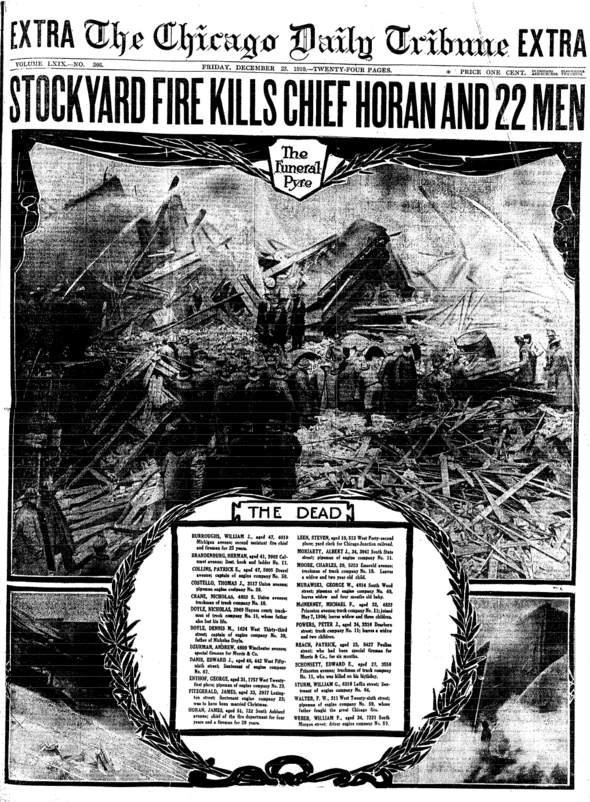IFSI Library Lending Policies
Local Lending (Illinois Residents Only)
- The checkout period is 4 weeks.
- Extensions are considered individually.
- Pick up requested materials at the library circulation desk.
- Bring your photo ID to set up a lending account.
Interlibrary Loan (ILL)
- The checkout period is 6 weeks.
- IFSI can send materials directly to your local public library through Interlibrary Loan.
- You must have a public library card.
- It may take up to two weeks for items to arrive.
Union Stockyards Fire: Introduction

Newspaper Cover from the Chicago Daily Tribune.
In 1910, Chicago’s Union Stockyards and Transit Company was one of the world’s largest centers of industry. The 450-acre site contained thousands of wooden animal pens, barns, haylofts, slaughterhouses, packing plants, and warehouses owned and operated by more than 100 separate meatpacking businesses. The Union Stockyards, famously documented in Upton Sinclair’s The Jungle, established Chicago as the “Hog Butcher to the World,” but the site was also home to the worst fire service disaster in Illinois history.
At 4 AM on December 22, 1910, a night watchman reported a fire in the basement of a six-story cold storage building operated by the Nelson Morris Company. The refrigerated warehouse was a particularly dangerous fire hazard as the interior walls and floors were wooden and soaked in animal fat and grease. Furthermore, the warehouse contained hundreds of cured hogs that were preserved with saltpeter, one of the main ingredients in gunpowder. Although Chicago firefighters responded within minutes from the two stockyard firehouses and from elsewhere in the city, any hope of dousing the fire before it spread to the rest of the building was lost when the firefighters discovered that the nearby fire hydrants had been shut off to prevent freezing. The warehouse was engulfed in flames by the time firefighters located and activated the water valves that fed the fire hydrants.
Numerous physical obstacles further restricted the fire fighting efforts, as railway cars, brick walls, and other warehouses closely surrounded the cold storage building. These obstructions made it impossible to set up ladders and, as a result, the firefighters were unable to reach the warehouse’s upper floor windows to open the iron shutters and release the pressure that was building up inside. The heat from the fire caused the cold air inside the refrigerated warehouse to expand at a dangerous rate and, at about 5 AM, the pressure inside the building produced a massive explosion. Chief Fire Marshal James Horan had just arrived and was directing operations from the building’s loading dock when the explosion occurred. An entire six-story wall collapsed on the loading dock, killing Horan, 2nd Assistant Chief Fire Marshal William Burroughs, three captains, four lieutenants, and twelve other firefighters.
Fire fighting efforts were severely complicated by the explosion, not only because the command structure was decimated, but also because the blast had set a nearby seven-story lard house on fire. Moreover, department personnel were diverted to try to rescue the firefighters buried by the collapsed wall. First Assistant Chief Charles Seyferlich, now in command, called in several special alarms, bringing more than 50 engine companies and hundreds of offduty firefighters to the scene. Fire fighting operations lasted for more than 24 hours before the blaze was completely extinguished and the last bodies were recovered from the rubble. With 21 firefighters killed, the Union Stockyard Fire ranks behind the 9-11 Terrorist Attacks and the 1947 Texas City Disaster as the third largest loss of firefighters in a single event in U.S. history.
Summary written by Adam Groves.
Resources at IFSI Library
-
Chicago's Forgotten Tragedy by
Call Number: TH9505.C4.C45 2010ISBN: 9781452079387Publication Date: 2010-09-23This book chronicles the history and beginning of the Chicago Fire Department, as well as information about forgotten fires, including the Union Stockyards fire of 1920 (pgs 126-163). -
 Great Chicago Fires: Historic Blazes the Shaped a City
by
Call Number: TH9445.P8C43 2001ISBN: 1893121070Publication Date: 2001This book discusses the great fires of Chicago, including the Union Stockyards fire of 1910, which is featured on pages 40-48.
Great Chicago Fires: Historic Blazes the Shaped a City
by
Call Number: TH9445.P8C43 2001ISBN: 1893121070Publication Date: 2001This book discusses the great fires of Chicago, including the Union Stockyards fire of 1910, which is featured on pages 40-48. -
 Union Stockyards Fire (Chicago, Ill., 1910) Collection
This archival collection includes secondary resources related to the history and study of the Union Stockyards Fire.
Union Stockyards Fire (Chicago, Ill., 1910) Collection
This archival collection includes secondary resources related to the history and study of the Union Stockyards Fire.
Online Resources
-
1910 Stock Yards Fire RememberedThis link goes to an article and radio story done by Chicago's local CBS affiliate, and it looks back on the events of the fire and how its being remembered 100 years later.
Librarian
IFSI Library Information
Library Hours:
8:00 am - 5:00 pm
Monday - Friday
Special operating hours may be held during events.
IFSI Library Staff:
Lian Ruan, Head Librarian: lruan@illinois.edu
Diane Richardson, Reference & User Training Librarian: dlrichar@illinois.edu
David Ehrenhart, Assistant Director for Library Operations: ehrenha1@illinois.edu
IFSI Library Facebook:
Libguide created by Quinn Stitt
Contact fsi-library@illinois.edu with questions or concerns.

